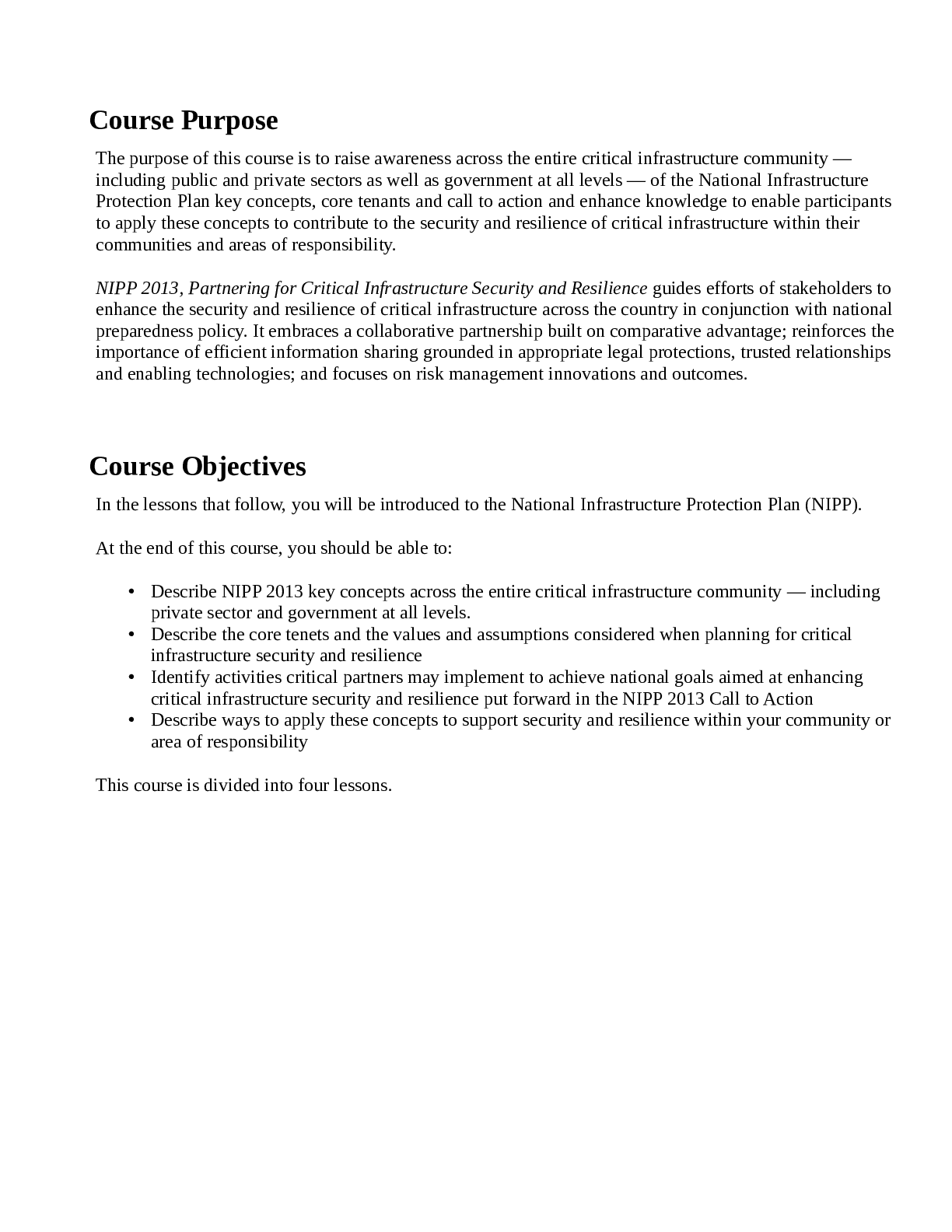
AQA GCSE MATHEMATICS 8300/3H Foundation Tier Paper 3 Calculator Mark scheme June 2021 Version: 1.0 Final
$ 6

OCR A Level Psychology Paper 1 H567-01 Research Methods June 2022 QUESTION PAPER
Construction and The Built Environment > STUDY GUIDE > Final Exam for IS 860.C The National Infrastructure Protection Plan, An Introduction (All)
Course Purpose Course Objectives The purpose of this course is to raise awareness across the entire critical infrastructure community — including public and private sectors as well as government ... at all levels — of the National Infrastructure Protection Plan key concepts, core tenants and call to action and enhance knowledge to enable participants to apply these concepts to contribute to the security and resilience of critical infrastructure within their communities and areas of responsibility. NIPP 2013, Partnering for Critical Infrastructure Security and Resilience guides efforts of stakeholders to enhance the security and resilience of critical infrastructure across the country in conjunction with national preparedness policy. It embraces a collaborative partnership built on comparative advantage; reinforces the importance of efficient information sharing grounded in appropriate legal protections, trusted relationships and enabling technologies; and focuses on risk management innovations and outcomes. In the lessons that follow, you will be introduced to the National Infrastructure Protection Plan (NIPP). At the end of this course, you should be able to: • Describe NIPP 2013 key concepts across the entire critical infrastructure community — including private sector and government at all levels. • Describe the core tenets and the values and assumptions considered when planning for critical infrastructure security and resilience • Identify activities critical partners may implement to achieve national goals aimed at enhancing critical infrastructure security and resilience put forward in the NIPP 2013 Call to Action • Describe ways to apply these concepts to support security and resilience within your community or area of responsibility This course is divided into four lessons. NIPP Evolution Lesson 1 Overview Today’s unified approach to critical infrastructure security and resilience is guided by the requirements of Presidential Policy Directive 21: Critical Infrastructure Security and Resilience, issued by the President in 2013. While NIPP 2013 retains the basic building blocks of previous NIPPs, it also represents a significant evolution in several areas. For example, the updated Plan: • Elevates security and resilience as the primary aim of critical infrastructure planning efforts; • Calls for the establishment of national priorities—determined jointly by public and private sector partners—that will drive action at the national level and inform the development of goals and priorities at the sector, State, Local, Tribal, Territorial (SLTT) and regional levels; Focuses on establishing a process to set critical infrastructure national priorities determined jointly by the public and private sector; • Directs joint decisionmaking by public and private sector partners initiated at the sector, SLTT and regional levels; • Drives action at the federal level that in turn informs development of national goals and priorities • Supports execution of the National Plan and achievement of the National Preparedness Goal at both the national and community levels, with focus on leveraging regional collaborative efforts; and • Integrates cyber and physical security and resilience efforts into an enterprise approach to risk management. Examples of natural and manmade disasters, such as the Oklahoma City bombing, Hurricanes Katrina and Sandy, significant cyber-attacks and disruptions to the power grid, have impacted America's national and economic security as we are increasingly reliant on critical infrastructure, including cyber-based information systems. Regardless of what kind of hazard occurs within the Nation (natural or manmade), critical infrastructure is affected in some significant way (for example, disruption, damage, or destruction). When our critical infrastructure isn’t fully functional, society suffers because the products and services provided by critical infrastructure underpin everything that we rely on to live our lives – food, water, healthcare, electricity, communications, transportation, etc. By the end of this lesson you will be able to: • Define critical infrastructure, security and resilience. • Describe the unifying structure for integration of security and resilience efforts. • Explain the importance of critical infrastructure partnerships. • Recognize the seven Core Tenets and explain how they support critical infrastructure security and resilience Audio Transcript Critical Infrastructure Critical Infrastructure Critical infrastructure, such as water, energy, electricity and petroleum products, represent day-to-day goods and services that are a part of the life of every single American. Critical infrastructure provides the foundation for the Nation’s ability to maintain our way of life. Protecting the critical infrastructure of the United States is essential to the Nation’s security, public health and safety, economic vitality and way of life. Disruption of America’s critical infrastructure could significantly interrupt the functioning of government and business alike and produce cascading effects far beyond the targeted sector and physical location of the incident. Direct terrorist attacks and natural, manmade, or technological hazards could produce catastrophic losses in terms of human casualties, property destruction and economic effects, as well as profound damage to public morale and confidence. The National Infrastructure Protection Plan is the path forward toward building and enhancing protective measures for the critical infrastructure that sustain commerce and communities throughout the United States. Our national well-being relies upon secure and resilient critical infrastructure—those assets, systems and networks that underpin American society. NIPP 2013 guides the national effort to manage risk to the Nation’s critical infrastructure. This national effort is shared by all levels of government and owners and operators of critical infrastructure. The Nation’s critical infrastructure is largely owned and operated by the private sector; however, Federal, State, Local, Tribal and Territorial governments also own and operate critical infrastructure, as do foreign entities and companies. Critical infrastructure includes systems and assets, whether physical or virtual, so vital to the United States that the incapacity or destruction of such systems and assets would have a debilitating impact on security, national economic security, national public health or safety, or any combination of those matters. Some examples of critical infrastructure include: • Tunnels serving as a primary conduit for transportation, water, electric, communications and gas lines • Supply lines bringing power, communications, food and water to a community • Financial services underpinning our economic system National Infrastructure Protection Plan (NIPP) The NIPP Mission and Vision The NIPP Mission The NIPP Vision NIPP 2013 influences critical infrastructure security and resilience planning at all governmental and owner and operator levels by establishing a vision, mission and goals that are supported by a set of Core Tenets focused on risk management and partnership. Building on the partnership and risk management framework introduced in 2006, the 2013 update is informed by changes in the risk, policy and operating environments and from experiences gained and lessons learned since the previous NIPP was issued. The strategic direction is driven by a common vision and mission; a Nation in which: • Physical and cyber critical infrastructure remain secure and resilient; • Essential services and products continue to be delivered in the face of incidents; and • Communities and businesses adapt to changing conditions and withstand and rapidly recover from potential disruptions. This vision complements and supports the President’s priorities for national security, national preparedness and community resilience. Critical infrastructure partners collectively identify priorities, articulate clear goals, mitigate physical and cyber risks, measure progress and adapt based on feedback and the changing environment to strengthen security and resilience. Click on the “Mission” and “Vision” boxes to read th [Show More]
Last updated: 3 years ago
Preview 1 out of 57 pages

Buy this document to get the full access instantly
Instant Download Access after purchase
Buy NowInstant download
We Accept:

Can't find what you want? Try our AI powered Search
Connected school, study & course
About the document
Uploaded On
Sep 16, 2022
Number of pages
57
Written in
All
This document has been written for:
Uploaded
Sep 16, 2022
Downloads
0
Views
71
Scholarfriends.com Online Platform by Browsegrades Inc. 651N South Broad St, Middletown DE. United States.
We're available through e-mail, Twitter, Facebook, and live chat.
FAQ
Questions? Leave a message!
Copyright © Scholarfriends · High quality services·